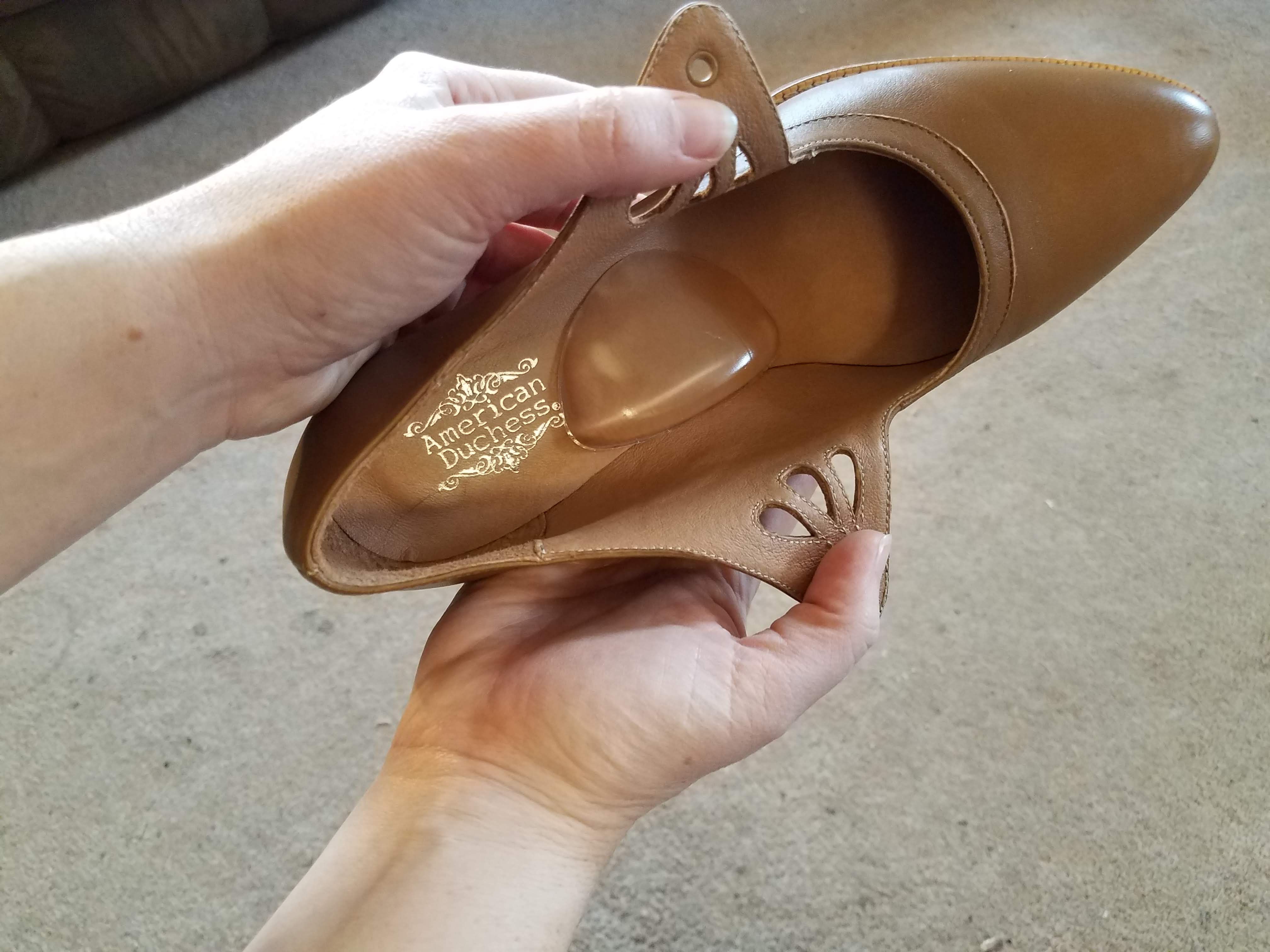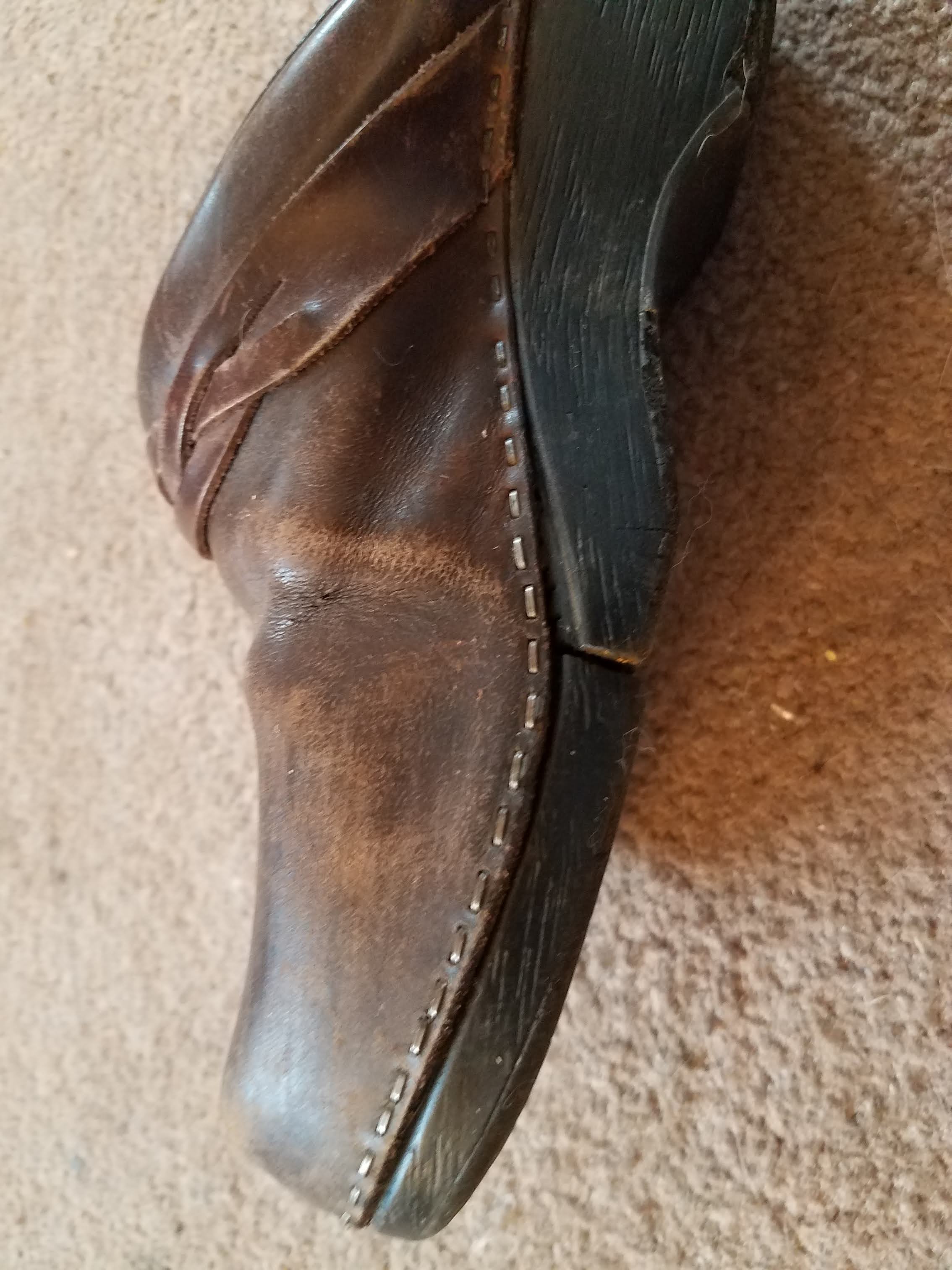Part 2 – Fit and Function
Since starting this blog, I’ve been blessed with a number of friends and readers who are willing to share their perspectives with me on a variety of topics. Their feedback sometimes includes gently calling me out and reminding me that not everyone can afford to buy the ethical or sustainable option. In part one of this post,[1] I encouraged readers, when possible, top opt out of fast fashion in favor of longer-lasting shoes. Here in part two, I am aiming to share information that will help you keep whatever shoes you have comfortable and functional for longer.
If the Shoe Fits…
When I recently purchased a new pair of dress shoes from American Duchess, I was surprised to receive a video link in my confirmation email that shared information about how to achieve the proper fit for your shoes, specifically how to stretch them where they are tight and add material where they are loose.[2] Since I had ordered a style that was discontinued (and therefore non-returnable), if they hadn’t fit, I would have had no option but to give them away.
The video described the different features of the foot and how each one affects the fit of a shoe. Since each pair of feet is different, sometimes with distinct differences between each of the feet (like with mine), mass-produced shoes will never be a perfect fit for anyone. The wearer, therefore, benefits greatly from adjusting the shoes to create a better – and unique – fit. While I am used to getting my clothes tailored (or doing it myself) after buying them to ensure a proper fit for my body, it never occurred to me to do the same with shoes.
Shoe fit and proper foot care came to my attention in a significant way earlier this year when I found out that lack of both (with an assist from genetics – thanks, Dad) led to a painful nodule in my plantar fascia.[3] With the addition of custom orthotic inserts, my running shoes, sneakers, and the vegan leather boots now fit like a dream, but my orthopedist was less optimistic about successfully creating anything that would properly cradle my foot in smaller shoes, like pumps or ballet flats. But it looks like I have some recourse there… even with sandals!

Making them Fit
The main reason I get rid of shoes is because I don’t wear them, and the main reason I don’t wear them is because they’re uncomfortable. The culturally acceptable connection between women’s fashion and pain is a topic for another time, but as I come out of quarantine and into social settings again, I am doing what I can to normalize comfort and health over image, even in professional settings.
Where they’re loose:
Regardless of what kind of shoes you have (natural materials or synthetic), there are ways to improve the fit of your shoes and how they support your feet. I have incredibly high arches (which, after years of insufficient support, led to my current medical issue), so I was thrilled to discover the existence of adhesive inserts that cushion different parts of the foot, as needed.[5]
The arch inserts I bought are made of gel (yes, a synthetic material – I recognize the irony given the fact that I try to minimize consumption of synthetics wherever possible) and have a washable adhesive on the bottom, meaning that they can be removed and reused in different shoes (even sandals!) I was shocked at just how sturdy the adhesive was, and I feared that I might pull the lining off of the bottom of my new American Duchess shoes when I transferred them over to my favorite pair of leather boots.
The boots, which I have had for possibly two decades now, are not comfortable, but I love them. I usually pad my feet with thick socks to cushion the impact on the balls of my feet as I walk in them. With the addition of the inserts, my weight (normally carried on the balls of my feet and my heels) was more evenly distributed, and even after being out and about in them for about seven hours, I was only in mild discomfort. “Mild discomfort” still isn’t ideal, but I was expecting severe pain after pampering my feet in nothing but house shoes for the past year and a half.

Where they’re tight:
When my shoes are too tight around the toes, it’s usually because my feet slide forward in the shoe – an issue that proper arch support seems to minimize or eliminate altogether. However, if parts of your shoes are generally tight, there are options for stretching them to achieve more space. It is important that your foot has enough room to function properly because you can seriously injure yourself if not. (I know someone with pinched nerves in her feet from wearing shoes that were too narrow.)
For leather shoes (or other natural materials, such as linen or canvas), you can use a shoe stretch spray, as recommended by American Duchess,[6] or a 1:1 solution of rubbing alcohol and water, as recommended by Land’s End. [7] Spray the area that needs to stretch and walk around in the shoes for 20 to 30 minutes or insert a shoe stretcher. Of course, using your own feet is the cheaper option without having to buy shoe stretching equipment, but a shoe stretcher can do the work overnight or while you do something else.
For synthetic shoes, there are a number of options available as well. I will note that the vast, vast majority of “vegan leather” on the market is plastic, which is why I use the terms interchangeably here. It is less supple than leather, but it can be stretched without damaging if you do it slowly and carefully. The most common trick I found in my research is to use a hairdryer to heat up the area in question, and then, wearing thick stocks to protect your feet and stretch the shoes, walk around in them until they cool down.[8] Do not heat the shoes while they’re on your feet – just to be safe.

Making them Last
Taking care of an investment means extra time, attention, and effort, to be sure. Regardless of whether you’re wearing cheap or expensive, synthetic or natural, proper care will keep your shoes attractive and functional for longer. Even with the best care, synthetic materials will probably not last anywhere near as long as natural materials will. However, the better care you can take of either, the less often you’ll have to replace them.
Natural leather shoes call for far more care than I regularly give them. Even so, my beloved boots are closing in on (I think) twenty years, and they still look pretty good (with only a few polishes and heel repairs since I got them). With proper care, I’m sure they would look even better and have an even longer expected life. “Proper care” for leather shoes includes each of the following steps, again from American Duchess:[9]
- Avoid inclement weather, if possible, to protect them in the first place.
- Clean off dirt/mud/salt right away when they do get soiled.
- Regularly condition the soles to keep them waterproof.
Shoemakers use mink oil for this, but I don’t know that I can do that. Yes, I recognize the irony of wearing leather boots and eschewing mink oil, but I still have a hard time even using byproducts from the fur industry. There are some alternatives available online that use beeswax and lanolin as ingredients for waterproofing, and the reviews seem generally positive. I haven’t purchased any yet, but I expect to go in that direction when caring for my new shoes.[10] - Keep the leather moisturized with lustre cream. Leather is skin, after all, and if it dries out, it will crack. Preventative maintenance is the key here.
- Give them a nice finish with a shoe polish to protect them and keep them easier to clean.
Vegan leather has a less-involved maintenance process, but it may not last nearly as long as the natural equivalent. It is not porous, and it is frequently coated in a plastic sealant, making it easy to clean with a damp cloth and mild detergent, which you should do whenever it gets dirty (after walking through mud or on salted, slushy roads in the winter). It is susceptible to damage from sunlight, so store it out of the sun.[11] Synthetic leather is prone to drying out and cracking, but you can use a conditioning spray to keep it in good shape. Such sprays can be found in auto shops.[12]
~
I hope this post has given you some information and resources to help you hold on to the shoes you love for longer, as well as consider your options when you finally need to replace them. If you have done your own shoe alterations or maintenance, I’d love to hear about it below.
Thanks for reading!
[1] https://radicalmoderate.online/sole-mates-part-1/
[2] https://www.youtube.com/watch?v=VMIoNst9IBs
[3] https://radicalmoderate.online/failing-at-my-new-years-resolution-or-a-crash-course-in-proper-foot-care/
[4] https://twitter.com/BroadhurstBooks
[6] https://www.americanduchess.com/products/angelus-professional-shoe-stretch
[7] https://www.landsend.com/article/how-to-stretch-shoes-that-are-too-tight/
[8] https://www.nae-vegan.com/en/how-to-break-in-new-shoes-including-vegan-shoes-without-the-pain_672.html?idb=81
[9] https://www.youtube.com/watch?v=cjrbZyptRnk
[10] https://www.amazon.com/Otter-Wax-All-Natural-Leather-Waterproofer/dp/B00IZPS7CA/
[11] https://getvegan.com/vegan-leather/#maintenance-and-repair
[12] https://www.wikihow.com/Prevent-Synthetic-Leather-from-Cracking
0 Comments